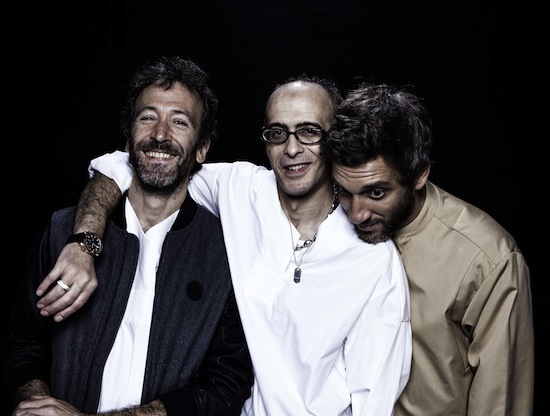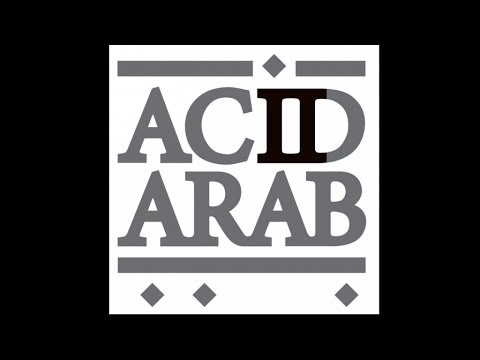Musique de France, the debut album proper by Guido Minisky and Hervé Carvalho was recorded for the most part in Shelter Studio in Paris’s arrondissement, which is where they are when we talk over Skype with the pair inside, appropriately enough, the vocal booth. Carvalho is the more effusive of the pair, with Minisky keeping his own counsel, amiable but perhaps slightly more wary.
Acid Arab began as a club night in a small venue called Chez Moune, while the pair exchanged tracks with friends on Facebook that they felt fitted an aesthetic, a genre of their own devising. (Whereas an English speaker might take ‘Arab’ to be the noun and ‘Acid’ the adjective, in French it’s the reverse – think of it more like ‘Arab acid’). The night took off "from the first flyer", according to Minisky, and the idea of creating their own music, or accepting contributions from others, flowed quite naturally from there. EPs and a compilation followed on the Parisian label Versatile, featuring their own work and guests including the label head DJ Gilb’R, Krikor, I:Cube and Dimmit, a Moroccan producer they’d come into contact with through SoundCloud. Jam sessions in Shelter Studio that made the cut were credited to a band called The Habibeats.
The pair are at pains to stress that there’s nothing too conceptual about their approach, but there’s undoubtedly something of the manifesto about their album’s title, and its range of guests – the Algerian star Rachid Taha, Syrian Rizan Said and Istanbul-based Cem Yildiz – at a time when debates around national identity and a general souring of spirit are sadly just as prevalent in France as over here. It also speaks of an international brother- and sisterhood of night people, as though the after-hours hedonism of cities from Paris to Oran to Cairo were sheltered by the same warm, nocturnal cloak.
Acid Arab really began as a banner for tracks which you felt had a common feel. Was radio one of the places you discovered these tracks?
Hervé Carvalho: Yes, Radio Nova certainly, where you can hear North African music, and music from the Middle East as well, and reggae. We kept coming back to the same stuff, disco edits by Turkish DJ Baris K – he does edits of Turkish funk and psychedelic classics from the ’60s and ’70s – and then there was the Rene Bendali ‘Tanki Tanki’ edit by Rabih Beaini – well it was kind of a secret at the time that it was Morphosis – but that was a foundational track for us.
How did you come together with your label, Crammed Discs?
Guido Minisky: It was just an email – we said we were looking for a label to put out an album, and they said, "OK, it’s us."
How familiar were you with the label’s history, people like Hector Zazou for example?
HC: Oh, Hector Zazou is really a model for us – the Noir et Blanc album with Bony Bikaye is a real standard bearer for its mix of Congolese and electronic music in a way that’s elegant, radical, respectful, all these approaches that we try to have in regards to music from the Maghreb or the Middle East.
How do you avoid it being gimmicky?
HC: It’s a question of exploration, working in the studio with Pierrot [Casanova, the lynchpin of Shelter Studio] until we find something that really gets us in our guts, something a bit wilder. There has to be that trancey aspect. Then it’s just a question of our reference points, which I think you can hear on the album – early ’90s techno, UK acts like Chemical Brothers and The Prodigy, Plastikman; we try to go all the way with these sounds. We never say, "We’re going to make something like the Chemical Brothers" – we wouldn’t be able to – but those influences come through. Something a bit rough, a bit sweaty and raw. And if we can manage to integrate a Berber or a Lebanese dapke rhythm, it can match quite naturally.
But it’s not that conceptual… well, that said, on a track like ‘Medahat’ for example, we wanted something in the spirit of medahat music, which is Algerian on the whole, with the sound of the gasba and where the rhythms are almost jungle-like.
I like ‘Medahat’ for its sense of space and its rather dense textures.
HC: That’s also the spirit of Shelter Studio as well, this industrial quality – Pierrot’s a big fan of Suicide, Throbbing Gristle and that kind of thing too.
How much do you use samples? Do you sample live playing?
HC: Where there are samples, they’re used atmospherically, down in the mix, as texture, but not as a main hook for the track. For the leads, a lot of it is our keyboard player Kenzi [Bourras], then there are parts that sound like oriental keyboards that are sequencers.
What about the hook based on a stringed instrument – presumably a buzuq or bouzouki – on ‘Buzq Blues’, is that something played then looped?
HC: Well there you go, I’ve just talked rubbish because that’s a sample! But it’s the only one like that. On the last track, ‘Tamuzica’, for example, with Jawad El Garrouge, it was a lot of editing to build the track, it wasn’t one take where he played it in one go – there are lots of little sections that we cut up and edited together to make the final version we wanted.
In terms of collaborating with singers, was it you who approached all of them?
HC: With Rachid [Taha] we have the same booking agent, we’d met several times. We did it in a studio that he often uses in Paris.
It’s not a typical Rachid Taha track at all.
HC: Precisely, it’s a bit darker… and I think it really suits him. What’s come out when I’ve played it to other people is that they were surprised to hear his natural voice, the timbre of his speaking voice.
In the current climate, the title of the album seems to be perhaps not a provocation precisely, but it’s difficult not to take it as being political on some level.
GM: It’s saying, "France can be this too."
HC: It’s not so much a provocation as a… statement. That it’s not about exoticism, we’re not necessarily looking further than what’s outside our house. It’s the France we live in and that we’ve grown up in.
Can you tell me about the sleeve by Lamia Ziadé – the EPs were fairly sober by comparison, featuring basically just the logo basically.
HC: It was really just something we loved, a book of her work that was a present, and we managed to contact her. She’s a Lebanese illustrator. She loved our music so she was happy to come up with a sleeve for us. For me it was also about a relationship to Matisse, who’s a painter she’s really interested in; I saw a lot of him in her work and I was really interested in that kind of trip.
GM: You see a woman in a cabaret with a whisky in her hand. After that, everyone can interpret that as they wish. It’s full of meaning but also very light.
Is it a picture that reflects certain parts of Paris?
GM: It could be Paris, or the Middle East.
HC: In fact the book, which is called Ô Nuit, Ô Mes Yeux, tells the stories through illustrations and short texts, of Egypt before, during and after the war, and of these divas like Fayrouz and Oum Kalthoum. And a lot of the stories she tells could just as easily be found in Balzac’s Lost Illusions or the Paris of today. It’s universal, it’s the city at night. Humanity, basically.
For Mosaiques, you’re playing the same night as another one of your collaborators, Sofiane Saidi.
HC: Oh amazing! I didn’t realise that. I hope we’ll be able to do ‘La Hafla’ live with him.
How did it go with him?
HC: It was brilliant, he totally understood what we were going for. He lives it, he’s an Acid Arab guy.
What makes an Acid Arab person?
HC: Well he knows raï music like the back of his hand, you know he’s really from Oran, he’s also a nighttime guy, you meet him out at night, at festivals, in clubs, he’s rock & roll, techno, raï, all at once. He came to the studio, heard what we’d done and got it straight away, wrote incredible lyrics, all done and dusted.
GM: He’s an interesting guy as well because he was part of the Transglobal Underground crew in the ’90s.
Do you feel the name Acid Arab will ever become restrictive?
HC: Well, as I say, it’s not a conceptual thing, it’s what we do naturally.
GM: We don’t really ask ourselves questions like that. That only comes from others.
HC: It’s not like we would do Acid Malagasy or something like that. With Pierrot we had been making music together for a long time and it gradually developed this way – it wasn’t like we suddenly said, "Let’s take what we can from this and move on to something else." That doesn’t make sense for us.
The feedback has been brilliant from people such as Gilles Peterson.
HC: It’s been great, especially for us little Frenchies.
Do you mean that, is that still a surprise?
HC: Yes, especially when it comes to electronic music.
In spite of French touch and so on?
HC: Yes, as DJs certainly. We played a night organised by Gilles in Sheffield where it was really UK bass, the home of bleep, etc, Gilles really tearing it up, and then we arrive with our disco, techno, whatever, we feel a bit polite compared to the Brits.
Hopefully there will still be clubs left here for you to play in. How’s it going on that side of things in Paris?
HC: In Paris it’s an explosion. In Paris, outside it, there are clubs opening all over the place, in the suburbs. It’s really interesting at the moment. I go out less now and see it from a distance but I have spies! The other weekend Concrete organised an event in the Gare Saint-Lazare with thousands of kids and a 100 per cent French line-up, with 20-year-olds doing live house and techno…
GM: Rubbing shoulders with DJs who are in their forties.
HC: For a while it was very cliquey, segregated but it’s opening up a lot with this generation – it’s a lot less purist, a lot more open. I think the point of view of younger people regarding DJs has really evolved. When it was just laptops everyone thought they could do it, but it had its limits because we heard so much poor quality stuff, bad mixing.
GM: I think Concrete has been important, it has certainly been symbolic of a return to a taste for DJs who have a bit of background, some baggage, some knowledge, even skills with vinyl – OK, that’s a bit snobby, it can be CDs, vinyl, whatever, but when you know someone can’t just press the ‘sync’ button it does add something. And people who’d been, not forgotten but perhaps a little marginalised, like DJ Deep or Master-H, have been able to come back to the decks and be successful. It’s an interesting time.
Musique de France is out on October 7 via Crammed Discs. Acid Arab begin a European tour tomorrow at Reeperbahn Festival in Hamburg, taking in Mosaiques festival at Rich Mix in London on October 15; for full details and tickets, head here



